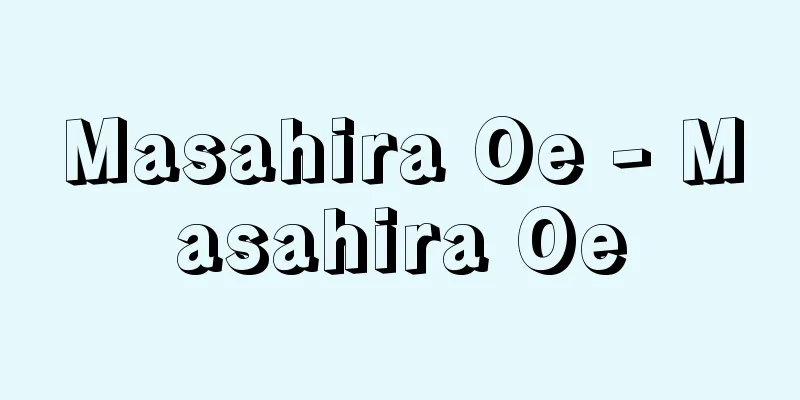Masahira Oe - Masahira Oe

|
Year of death: 16 July 1012 (6 August 1012) Year of birth: Tenryaku 6 (952) A scholar and official in the mid-Heian period. Junior Fourth Rank, Lower Grade, Shikibu Daifu. His father was Sakyo no Daifu Shigemitsu. He was taught by his grandfather Itoki from an early age, and as he grew up, he possessed a talent for learning that was unmatched. He became a monjosei at the age of 24, and was then promoted to Shusai (a person who passed the examination for the Ministry of Shikibu under the Ritsuryo system), and served as Kebiishi and other Kyoto officials, and became a monjo hakase at the age of 38. He also served as the Crown Prince's scholar, a chamberlain and a chamberlain to Emperor Ichijo. In 1001, he became the governor of Owari and went to his assigned province with his wife Akazome Emon to govern well. The irrigation channel that Masahira developed is called the Oe irrigation channel, and its benefits are still being distributed today. He was appointed to Owari no Kami again in 1009, but this time, halfway through his term, he requested to be promoted to Tanba no Kami in the neighboring province. It is said that he built the Owari Gakuin at this time, but this is thought to have been unrealized. He was highly trusted by the powerful man of the time, Fujiwara no Michinaga, and wrote many essays and prayers on his behalf. He also frequently attended poetry banquets and poetry gatherings, and was known for being the preface and title writer for poems. His talent for poetry and poetry was widely recognized. A glimpse of this can be seen in the anthology of poems, "Eribeshu," and the anthology of poetry, "Masahira Asonshu." He was also friends with Fujiwara no Sanesuke, who was known for his vast knowledge, and when Masahira died, Sanesuke said, "There is no one who can compare to him as a great Confucian scholar, and the art of literature has perished." His wife, Emon, wrote a poem: "The crimson color of our layered robes has become our sleeves moist with tears." Masahira, who had been frequenting the daughter of a priest at the Inari Shrine, was sent a poem by Emon, and it is said that he felt embarrassed and returned to Emon. The couple had two children, Kyoshu and Eijiju. <References> Shosuke Ozone, "Masahira Oe" (Chinese Literature Studies, No. 10) (Oboriya Hisashi) Source: Asahi Japanese Historical Biography: Asahi Shimbun Publications Inc. About Asahi Japanese Historical Biography |
|
没年:長和1.7.16(1012.8.6) 生年:天暦6(952) 平安中期の学者,官人。正四位下,式部大輔。父は左京大夫重光。幼くして祖父維時の教えをうけ長じておよぶものがなかったというほどの才学の持ち主。24歳で文章生となり,次いで秀才(律令制下で式部省の登用試験に合格した者)に補せられ,検非違使ほかの京官を歴任し,38歳で文章博士となった。さらに東宮学士,一条天皇の侍読,侍従などを務めた。長保3(1001)年に尾張守となり妻の赤染衛門と共に任国に下り善政を行った。匡衡の整備した灌漑用水は大江用水の名で呼ばれ,いまもその余恵を施している。寛弘6(1009)年再度,尾張守に任じられたが,このたびは任なかばで希望して近国の丹波守にかわっている。このとき尾張学校院を建てたというが,実現はしなかったとみられる。ときの権力者藤原道長の信望厚く,文章の代作や願文の類を多作した。また詩宴,歌会によく出席し,序者,題者となるなど詩才,歌才は衆目の認めるところであった。その一端は詩文集の『江吏部集』や歌集の『匡衡朝臣集』などからうかがえる。また博識をもって知られる藤原実資とも交友があり,匡衡の死に際し実資は「名儒として比肩する人なし,文道の滅亡」とまでいっている。妻の衛門は「重ねてし衣の色のくれなゐは涙に湿める袖となりけり」と詠じた。かつて稲荷社の神官の娘へ通いつめた匡衡は,衛門から一首の歌を送られ,恥ずかしくなって衛門のもとへ戻ったという。ふたりの間に挙周,江侍従という子がいる。<参考文献>大曾根章介「大江匡衡」(『漢文学研究』10号) (朧谷寿) 出典 朝日日本歴史人物事典:(株)朝日新聞出版朝日日本歴史人物事典について 情報 |
Recommend
Brachycam - Brachycam
An annual plant of the Asteraceae family. There ar...
Nutrient isolation - Nutrient isolation
...For example, the operation of segregation bree...
Fixed term deposit - teikiyokin
A deposit with a fixed deposit period that is det...
Akigawa
The name of a former city in the western part of ...
Oshira Saibun - Oshira Saimon
...The latter is a tale of a marriage between a h...
Iseyamada Town Magistrate - Iseyamada Town Magistrate
…One of the Edo Shogunate's local administrat...
Mr. Osuga
A powerful clan in Shimousa in the Middle Ages. Th...
Whale shark
…It is also called the whale shark. Its English n...
Tanji Road - Tanji Road
An ancient road that is said to have run from Izum...
Incense sticks - Incense sticks
Rakugo. The original story is "Hangonkou"...
Priscilla
...His background is unclear, but he was probably...
Senchado - Senchado
A method of drinking tea. It began as a hobby amo...
Uranium ore
...Some species, such as autunite, emit a bright ...
"Imosezuka Matsuni Sakura" - Imosezuka Matsuni Sakura
...Another work that incorporates the idea of &...
American black bear
A mammal of the Ursidae family in the carnivora or...









